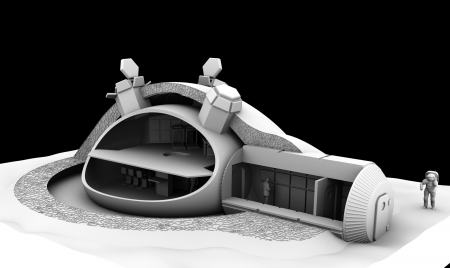May 19, 2015 – Another NASA challenge was launched on May 16th, this one called The 3D-Printed Habitat Challenge. The goal to develop safe, sustainable off-world housing. Deadline to register is July 15th. Submission deadline is August 3rd. In the first phase of the competition entrants are asked to submit state-of-the-art concepts that use 3-D printing manufacturing. First phase winners will receive $50,000 U.S. to be awarded at the 2015 Maker Faire to be held in late September in New York City. Second phase competition beginning September 26th will focus on actual fabrication and materials. Two prizes of $1.1 million will be awarded, one for structural components and the other for fabrication.The idea is for the designers to use native materials they will find on hand including the surface regolith whether lunar or Martian plus recyclables from the garbage produced by human space crews during missions.
NASA has been experimenting with 3D printing on the International Space Station (ISS), its latest triumph a cappuccino maker which made lots of headlines recently. The agency has also 3D printed a rocket bell successfully using copper alloys for ink. SpaceX, one of NASA’s commercial partners, has also incorporated 3D printing into both its Falcon rocket program and the manufacturing of the Dragon capsule.
NASA’s vision is to send autonomous habitat manufacturing robots to places like the Moon and Mars to construct shelters for crews that follow. It also hopes that through this contest it can harness the power of 3D printing to develop manufacturing capabilities that transfer here to Earth for building permanent, affordable, sustainable housing.
The scenario described in the guidelines is of a NASA crew of four heading to Mars in 2035 where they will upon arrival take up residence in a previously built accommodation approximately 93 square meters (1,000 square feet) in size. This habitat will include all things required to sustain the human crew – cooking areas, sleeping quarters, bathrooms, etc. The habitat prototype to be built by the contestant entries here on Earth will have to use semi-autonomous robots operating 3D printing technology using as materials what’s available to them locally. The choice of location for building the prototype must approximate the conditions of a Martian site selected by the contestants. The habitat must incorporate environmental control and life support systems that produces freshwater and oxygen and maintains air quality, pressure and temperature.
In phase one a team of adjudicators will review all applicants selecting the top 30 who will then be notified and asked to present detailed architectural plans along with models for judging at the Maker Faire. Subject matter experts will then select first, second and third place winners with a top cash prize of $25,000, a runner up prize of $15,000 and a third place award of $10,000. Based on the models displayed at the Maker Faire the public will have the opportunity to vote for the People’s Choice Award. The prize winners will then begin phase two where the cash awards as stated above will be much more significant.








